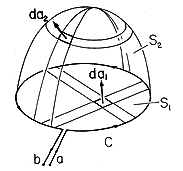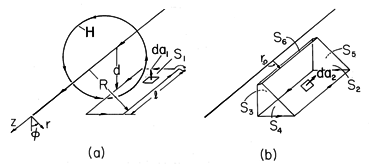

1.7
Gauss' Integral Law of Magnetic Flux
The net magnetic flux out of any region enclosed by a surface S must be zero.
This property of flux density is almost implicit in Faraday's law. To see this, consider that law, (1.6.1), applied to a closed surface S. Such a surface is obtained from an open one by letting the contour shrink to zero, as in Fig. 1.5.1. Then Faraday's integral law reduces to
Gauss' law (1) adds to Faraday's law the empirical fact that in the beginning, there was no closed surface sustaining a net outward magnetic flux.
Illustration. Uniqueness of Flux Linking Coil
An example is shown in Fig. 1.7.1. Here a wire with terminals a-b follows the contour C. According to (1.6.8), the terminal EMF is found by integrating the normal magnetic flux density over a surface having C as its edge. But which surface? Figure 1.7.1 shows two of an infinite number of possibilities.
Figure 1.7.1. Contour C follows loop of wire having terminals a-b. Because each has the same enclosing contour, the net magnetic flux through surfaces S1 and S2 must be the same. The terminal EMF can be unique only if the integrals over S1 and S2 result in the same answer. Taken together, S1 and S2 form a closed surface. The magnetic flux continuity integral law, (1), requires that the net flux out of this closed surface be zero. This is equivalent to the statement that the flux passing through S1 in the direction of da1 must be equal to that passing through S2 in the direction of da2. We will formalize this statement in Chap. 8.
Example 1.7.1. Magnetic Flux Linked by Coil and Flux Continuity
In the configuration of Fig. 1.7.2, a line current produces a magnetic field intensity that links a one-turn coil. The left conductor in this coil is directly below the wire at a distance d. The plane of the coil is horizontal. Nevertheless, it is convenient to specify the position of the right conductor in terms of a distance R from the line current. What is the net flux linked by the coil?
Figure 1.7.2. (a) The field of a line current induces a flux in a horizontal rectangular coil. (b) The open surface has the coil as an enclosing contour. Rather than being in the plane of the contour, this surface is composed of the five segments shown. The most obvious surface to use is one in the same plane as the coil. However, in doing so, account must be taken of the way in which the unit normal to the surface varies in direction relative to the magnetic field intensity. Selection of another surface, to which the magnetic field intensity is either normal or tangential, simplifies the calculation. On surfaces S2 and S3, the normal direction is the direction of the magnetic field. Note also that because the field is tangential to the end surfaces, S4 and S5, these make no contribution. For the same reason, there is no contribution from S6, which is at the radius ro from the wire. Thus,
On S2 the unit normal is i
, while on S3 it is -i
. Therefore, (3) becomes
With the field intensity for a line current given by (1.4.10), it follows that
That ro does not appear in the answer is no surprise, because if the surface S1 had been used, ro would not have been brought into the calculation.







 o E
o E 
 o H.
o H.
